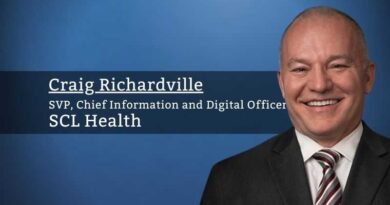Augmented intelligence will improve patient outcomes and reduce physician burnout
By Roxana Lupu, MD, MBA, CMIO, Sanford Health
As medical and diagnostic knowledge expands at a high rate, even the most experienced primary care doctors and clinical specialists may need help spotting patterns and calibrating risks in high-risk patients in ways that tap into the latest medical knowledge and treatments.
I work for Sanford Health, the nation’s largest rural health care provider, and we are working on designing algorithms that aim to augment the diagnostic techniques of our doctors with the latest computer-driven assistance.
Augmenting diagnosis and care
With success in compiling and delivering patient and practice information to the right digital places, we are now ready to take a second step forward: to harness the power of intelligent computers to scan data from a patient’s health and family history, tests and other clinical observations, and then augment those entries with “smart” alerts and customized recommendations for providers to better manage their patients.
We are starting small but still anticipating big results: Our first focus is to apply automated computer algorithms to identify the rising population of patients suffering from diabetes and obstructive sleep apnea. Chronic diseases like these are best managed when earliest detected – and better still, if anticipated and avoided altogether.
Left untreated, obstructive sleep apnea can lead to hypertension, heart disease and arrhythmias. Without early prevention or treatment, diabetes can lead to serious complications with the nerves, eyes and kidneys – complications that can be irreversible.
We are already seeing how artificial intelligence enables medical diagnostics and improves patient outcomes, specifically in radiology. Someday in the not-so-distant future, medical treatments in a range of specialties will be possible through artificially intelligent machines. In the meantime, capable computerization today can augment physicians’ skills to make clinical diagnoses, recommend treatment and save lives.
Relieving the cognitive burden
The cognitive burden on providers right now is intense; we are in uncharted waters as pandemic persists across the globe. Doctors can be overwhelmed: What treatment is best now? What protocols are available now and where? The fervent appetite for advanced research during the COVID-19 pandemic has only quickened the flood of new knowledge and new treatments.
A provider may not have all the details inclining a patient toward obstructive sleep apnea or diabetes, such as their complete medical history or family background as well as a range of other contributing lifestyle and genetic factors available at their fingertips during a visit.
Furthermore, attention to detail is required for a routine preventive visit. Today it has become even more time-intensive – it often includes discussing and reviewing a current list of medications, assessing whether the patient is up-to-date on preventive health screenings and immunizations while also listening and responding to their current health concerns.
With that in mind, my team at Sanford Health saw the immense value that would come from applying predictive models and risk stratification to our electronic records to inform clinical decision-making. We will now be able to leverage the data to deliver more personalized care through predictive models that consider and review all aspects of patients’ histories. These augmented intelligence capabilities will also be critical as we get deeper into value-based care, focusing on prevention and working upstream to keep our patients healthy.
Our first step in the current project has been to integrate obstructive sleep apnea and diabetes scores into the electronic health record across our system, then use the scores to prompt suggestions to caregivers for treatment. We’re also aiming to explore how we can apply that consolidated knowledge to the public health space to improve population health.
What will it look like if we succeed with augmented intelligence? Within the health record accessible to the provider will be the most advanced knowledge of the science delivered right in time, during a clinic visit.
Preventive care saves lives
What will it look like if we succeed with augmented intelligence? A physician will see a patient that is not yet diabetic but may have a 60% risk of developing diabetes in one year by points of reference in the electronic health record. Another patient may be at high risk for sleep apnea but so far lack obvious symptoms.
Our augmented intelligence tool will first provide the doctor with an immediate suggestion, then a clear, precise and intelligent report on why that alert was prompted, and finally a plan for a course of preventive action to help the provider and patient together avoid unhealthy behaviors and adopt new ones to steer away from to the development of those conditions.
Within the health record accessible to the provider will be the most advanced knowledge of the science delivered right in time, during a clinic visit. The information will allow the provider to have a meaningful discussion with the patient and intervene early to prevent the onset of diabetes or develop a care plan to avoid more serious complications. The provider may also be able to introduce options early to prevent obstructed sleep apnea disorder so that sleep deprivation doesn’t adversely affect workplace performance and overall health.
Deploying augmented intelligence will be a win-win for the patient and provider: We can improve health outcomes and reduce physician burnout by providing information to support clinical decision-making and prevent the onset of serious health conditions.



